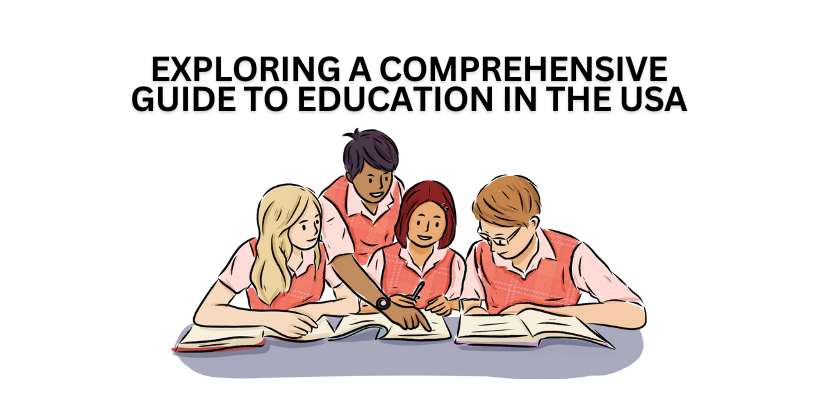Nelson Mandela once profoundly stated, “Education is the most powerful weapon that you can use to change the world.” In the United States, this sentiment resonates deeply. The American education system is celebrated worldwide for its inclusiveness, diversity, and unique capacity to offer students a tailored education. In this comprehensive guide, we will explore the intricate aspects of American education, from the dynamic college admissions process to the diverse world of financial aid, all while shedding light on the booming influence of online learning. Welcome to your roadmap to educational empowerment.
The Three Phases of Schooling in the USA
The American school system is divided into three primary phases, providing students with a well-rounded foundation:
- Elementary or Primary School (Grades K–5): This initial phase, spanning five years, lays the cornerstone of a student’s academic journey.
- Middle School or Junior High School (Grades 6–10): The subsequent five years further develop students’ knowledge across diverse subjects.
- Secondary School (Grades 11–12): The final two years of compulsory education lead to high school graduation, opening the doors to a myriad of higher education opportunities.
Upon graduating from secondary school, students can apply to colleges and universities for advanced education, setting the stage for diverse academic and career prospects.
Higher Education in the USA
The United States boasts some of the world’s most esteemed universities, recognized for their rigorous academic standards and the wide array of programs they offer. The journey through higher education comprises various levels:
- Associate Degree: A two-year, career-focused program that enables students to enter the workforce. This often serves as the initial half of a four-year bachelor’s degree.
- Bachelor’s Degree: This is the most common undergraduate degree, typically spanning three to four years. It includes core courses, electives, majors, and minors, providing students with a comprehensive education.
- Master’s Degree: The USA offers two types of Master’s degrees: professional programs, which last one to three years, and academic Master’s programs spanning two years.
As of now, top-ranking American institutions include the Massachusetts Institute of Technology (MIT), Stanford University, Harvard University, the California Institute of Technology (Caltech), and many others.
College Admissions: Where Dreams Take Shape
Every year, a multitude of students embark on the exhilarating journey of college admissions. Here are the key components:
- Holistic Application Process: American colleges consider various factors beyond grades and test scores. They value extracurricular activities, personal essays, and letters of recommendation. This holistic approach allows students to showcase their unique qualities.
- Standardized Tests: The SAT and ACT have long been part of the admissions process, but in recent years, many institutions have adopted test-optional policies, allowing students to decide whether to submit their scores.
- Application Essays: Personal essays provide an opportunity for students to tell their stories and explain why they’re a great fit for a particular institution.
- Financial Planning: College admissions also involve understanding tuition costs, scholarships, and financial aid. Admissions officers assess a student’s eligibility for need-based aid.
Financial Aid: Making Higher Education Attainable
Higher education in the USA can be financially daunting, but numerous resources make it accessible:
- Federal Student Aid (FAFSA): The Free Application for Federal Student Aid is a critical starting point. It determines a student’s eligibility for federal grants, work-study programs, and loans.
- Scholarships: A myriad of scholarships are available, from merit-based to need-based, and they can significantly reduce the cost of education. Keep an eye on deadlines and eligibility criteria.
- Work-Study Programs: These offer on-campus job opportunities to help cover expenses while gaining valuable work experience.
- Private Scholarships: Organizations, institutions, and private donors often provide scholarships to students based on various criteria.
- Grants: Federal and state governments, as well as institutions, offer grants that don’t need to be repaid, making them a crucial part of financial aid.
The Rise of Online Learning: A Transformative Educational Frontier
Online learning has grown exponentially, particularly in the wake of global events. As of 2023, it’s essential to understand its evolving role:
- Flexibility: Online courses offer flexibility in scheduling, allowing students to balance work, family, and education.
- Diverse Programs: Many universities now offer fully online degree programs, from bachelor’s to doctoral degrees, spanning various fields.
- Self-Paced Learning: Students can adapt the pace of learning to match their understanding, ensuring a more customized education.
- Resource Availability: Online students often have access to a wealth of digital resources, from e-libraries to interactive study materials.
Education in the USA is a dynamic landscape, shaped by inclusiveness and an evolving approach to accessibility. College admissions, financial aid, and online learning continue to transform, enabling students to pursue their dreams regardless of their circumstances. This comprehensive guide serves as your ally in navigating the intricate path to educational empowerment in the United States.








